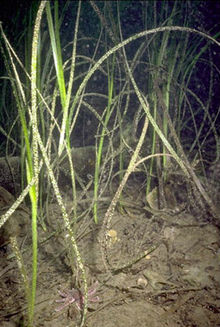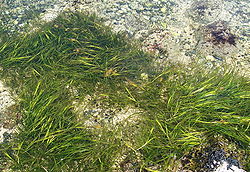- Zostera
-
Zostera 
Zostera marina Scientific classification Kingdom: Plantae (unranked): Angiosperms (unranked): Monocots Order: Alismatales Family: Zosteraceae Genus: Zostera
L. (1753)Species 16 species; see Classification

Global distribution map of Zostera. Green indicates presence. Synonyms Heterozostera (Setch.) Hartog
Nanozostera Toml. & Posl.Zostera is a small genus of widely distributed seagrass, commonly called marine eelgrass or (outside North America) simply eelgrass (not to be confused with the freshwater plant genus Vallisneria also called "eelgrass"). The genus Zostera contains sixteen species.
Contents
Ecology
Zostera is found on sandy substrates or in estuaries submerged or partially floating. Most Zostera are perennial. They have long, bright green, ribbon-like leaves, about 1 cm wide. Short stems grow up from extensive, white branching rhizomes. The flowers are enclosed in the sheaths of the leaf bases, the fruits are bladdery and can float.
Zostera beds are important for sediment deposition, substrate stabilization, as substrate for epiphytic algae and micro-invertebrates, and as nursery grounds for many species of economically important fish and shellfish. Zostera often forms beds in bay mud in the estuarine setting. It is an important food for Brant Geese and Wigeons, and even (occasionally) caterpillars of the grass moth Dolicharthria punctalis.
The slime mold Labyrinthula zosterae can cause wasting disease of Zostera, with Z. marina being particularly susceptible, causing a decrease in the populations of the fauna that depend on Zostera.
Zostera is able to maintain its turgor at a constant pressure in response to fluctuations in environmental osmolarity. It achieves this by losing solutes as the tide goes out and gaining solutes as the tide comes in.
Distribution
Zostera marina is widespread throughout northern areas of the Northern Hemisphere. It and Zostera noltii have both been recorded from Lough Foyle, Northern Ireland.[1]
Zostera capricorni occurs in Australia and New Zealand.
Classification
There are currently 16 species of Zostera, including four species formerly classified in the genus Heterozostera (now a subgenus):
- Zostera angustifolia
- Zostera asiatica
- Zostera caespitosa
- Zostera capensis
- Zostera capricorni
- Zostera caulescens
- Zostera chilensis
- Zostera japonica
- Zostera marina
- Zostera mucronata
- Zostera muelleri
- Zostera nigricaulis
- Zostera noltii
- Zostera novazelandica
- Zostera polychlamys
- Zostera tasmanica
Uses
Eelgrass has been used for food by the Seri tribe of Native Americans on the coast of Sonora, Mexico. The rhizomes and leaf-bases of eelgrass were eaten fresh or dried into cakes for winter food. It was also used for smoking deer meat. The Seri language has many words related to eelgrass and eelgrass-harvesting. The month of April is called xnoois ihaat iizax, literally "the month when the eelgrass seed is mature".[2]
Eelgrass once grew in abundance in Barnegat Bay, New Jersey, where it was harvested, dried and used for insulation in houses, such as the governor's summer mansion in Island Beach State Park. A blight decimated the eelgrass, which ended harvesting of the plant. The plant is making a gradual comeback.
Zostera has also been used as packing material and as stuffing for mattresses and cushions.
References
- ^ Blackler, H. (1951). "An algal survey of Lough Foyle, Northern Ireland". Proc. Roy. Ir. Accad 54B (6): 97-139.
- ^ Felger, Richard; Mary B. Moser. (1985). People of the Desert and Sea: Ethnobotany of the Seri Indians. Tucson: University of Arizona Press.
External links
Categories:- Alismatales genera
- Seagrass
Wikimedia Foundation. 2010.

